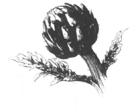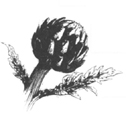Copyright 1998 by the California Artichoke Advisory Board. All rights reserved. Published in the United States by Celestial Arts, an imprint of the Crown Publishing Group, a division of Random House, Inc., New York. www.crownpublishing.com
www.tenspeed.com Library of Congress Cataloging-in-Publication Data
The California artichoke cookbook / from the California Artichoke Advisory Board ; edited and compiled by Mary Comfort, Noreen Griffee, Charlene Walker.
p. cm
1. Cookery (Artichoke) 2.
ArtichokeCalifornia. I. Comfort, Mary. II. Griffee, Noreen. III.
Walker, Charkene. IV. California Artichoke Advisory Board.
TX803.A7C35 1998
641.6532dc21 97-44106 eISBN: 978-0-307-78573-2 v3.1 To everyone who enjoys
good food, and to all the
growers who make it happen.
Contents
Introduction
As one of the worlds oldest known foods, artichokes enjoy a rich heritage and hold a special place in our history. First cultivated for food in the Mediterranean basin thousands of years ago, they remain a popular favorite throughout that part of the world to this day. The temperate climate is ideal for this hardy thistle and Italian, Greek, Turkish and Middle Eastern cuisines have inspired many classic artichoke dishes.

Artichokes traveled with Italian immigrants to the northern California coast during the late 1800s.
Relatively mild, usually frost-free winters and cool, foggy summers proved to be perfect growing conditions. Today, virtually 100 percent of the U.S. supply of artichokes is grown in California with most of the crop coming from the central coastal region. In fact this prickly immigrant reigns supreme as The Official Vegetable of Monterey County. Whenever we eat an artichoke, we are actually eating a flower bud. As a perennial in the thistle group of the sunflower (Compositae) family, the artichoke bud, if allowed to blossom, would measure up to seven inches in diameter and be a beautiful purple-violet color with a fragrance much like lilac.
In full growth, the artichoke plant spreads to cover an area about six feet in diameter and reaches a height of three to four feet. Long, arching, serrated leaves give the mature plant a fern-like appearance. California artichokes are available in most markets throughout the year. The peak season is the springMarch, April and May. They have a rich, meaty quality with a distinct nutlike flavor that makes them tremendously versatile and fun to eat!  Whether or not this is your first experience with an artichoke, we wish you good health and happy eating!
Whether or not this is your first experience with an artichoke, we wish you good health and happy eating!
Artichoke Basics
Selecting The Best
Choose artichokes that are heavy for their size. Artichokes come in sizes ranging from baby to jumbo and all are mature when picked.
Small or baby artichokes are ideal for marinating, sauting or adding to your favorite stews and pot roasts. Medium sizes are perfect for salads, side dishes and light meals. When properly trimmed, they can be sliced and sauted or added to stir-fry or pasta dishes. Serve the largest sizes as an appetizer with a dip or stuff them for a special entre. 
How To Store
An artichoke will look and taste fresh for up to one week if properly handled and stored. Do not wash before storing.
To keep longer than several days, drizzle a few drops of water on each artichoke, place in a plastic bag, seal airtight and refrigerate. Cooked artichokes should be cooled completely, covered and refrigerated for up to one week.
How To Prepare
Wash the artichoke under cold, running water. To preserve its color, use only stainless steel knives for any cutting.
Immediately rub any cut surface with lemon juice or place artichoke in acidulated water. (Add 1 tablespoon vinegar or lemon juice per quart of water.) Acidulated water helps prevent discoloration of artichokes.Whole Artichokes: Pull off the lower outer leaves of the artichokes.
Cut the stem to 1 inch or less. If desired, cut off the top quarter and tips of the remaining leaves. 
 Artichoke Halves: Cut in half lengthwise and remove fuzzy centers. Artichoke Quarters: Cut halves in half again. (Remember to rub cut surfaces with lemon juice or place in acidulated water, as noted above.)Artichoke Hearts: Use small or medium-sized artichokes. Bend back the outer leaves of the artichokes until they snap off easily near the base.
Artichoke Halves: Cut in half lengthwise and remove fuzzy centers. Artichoke Quarters: Cut halves in half again. (Remember to rub cut surfaces with lemon juice or place in acidulated water, as noted above.)Artichoke Hearts: Use small or medium-sized artichokes. Bend back the outer leaves of the artichokes until they snap off easily near the base.
The edible portion should remain on the artichoke. Continue to snap off and discard dark green leaves until the central core of pale green is reached. Cut off the top 2 inches of artichoke; discard. Cut the stem to 1 inch or less. Trim the outer dark green layer from the artichoke bottom. Place in acidulated water.  Artichoke Heart Halves: Cut in half lengthwise.
Artichoke Heart Halves: Cut in half lengthwise.  Artichoke Heart Halves: Cut in half lengthwise.
Artichoke Heart Halves: Cut in half lengthwise.
Remove the fuzzy centers. Place in acidulated water. For Quarters or Wedges, cut in half again or smaller. Place in acidulated water. Artichoke Bottoms: Use large artichokes. Bend back the outer leaves of the artichokes until they snap off easily near the base.
The edible portion should remain on the artichoke. Continue to snap off and discard the dark green leaves until the central core of pale green is reached. Cut off the stem and top leaves inch above the base of the leaves; discard. Trim the outer dark green layer from the artichoke bottom. Remove fuzzy center; discard. Baby Artichokes: Baby artichokes have no developed fuzz or fibrous leaves in the center. Baby Artichokes: Baby artichokes have no developed fuzz or fibrous leaves in the center.
So, with careful trimming, you have a completely edible artichoke. Bend back the outer leaves of the artichokes until they snap off easily near the base (illustration 1). Continue until the pale green core is reached. Cut off the top point where pale green meets dark green











 Artichokes traveled with Italian immigrants to the northern California coast during the late 1800s.
Artichokes traveled with Italian immigrants to the northern California coast during the late 1800s.  Whether or not this is your first experience with an artichoke, we wish you good health and happy eating!
Whether or not this is your first experience with an artichoke, we wish you good health and happy eating!

 Artichoke Halves: Cut in half lengthwise and remove fuzzy centers. Artichoke Quarters: Cut halves in half again. (Remember to rub cut surfaces with lemon juice or place in acidulated water, as noted above.)Artichoke Hearts: Use small or medium-sized artichokes. Bend back the outer leaves of the artichokes until they snap off easily near the base.
Artichoke Halves: Cut in half lengthwise and remove fuzzy centers. Artichoke Quarters: Cut halves in half again. (Remember to rub cut surfaces with lemon juice or place in acidulated water, as noted above.)Artichoke Hearts: Use small or medium-sized artichokes. Bend back the outer leaves of the artichokes until they snap off easily near the base. Artichoke Heart Halves: Cut in half lengthwise.
Artichoke Heart Halves: Cut in half lengthwise.